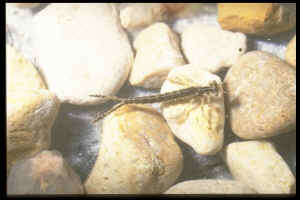 |
| Zygoptera |
 |
| Discover Life | All Living Things | Insecta | Odonata | Zygoptera |
Damselflies have four large membranous wings of nearly equal size which are held together over their back when they are at rest except for the Lestidae which hold them slightly open. Wings are usually clear except for a spot at the end of the wing called a stigma. Some species have black or red coloration in the wings. Damselflies have long thin bodies that are often brightly colored with green, blue, red, yellow, black or brown. They have oblong heads with bulging eyes and very short antennae. Aquatic immature damselflies (naiads) have elongate bodies, long legs and three leaf-like appendages or gills on the tail. These appendages are used for oxygen transport. There are four families of damselflies (including the Protoneuridae). The largest species in Texas is Archilestes grandis in the family Lestidae. Spreadwing damselflies in the family Lestidae hold their wings somewhat open when at rest. Calyopterygidae are blackwinged damselflies (some have half black wings) and the ruby spot which has red at the base of the wings. Most of our species are in the family Coenagrionidae which commonly are found around ponds and streams. They can be found with many body colors but they always have clear wings. The Protoneuridae are small damselflies inhabiting streams in far south Texas.
| Index |
| Class | Insecta | Insects |
| Order | Odonata | Dragonflies & damselflies |
| Suborder | Zygoptera | Damselflies |
Groups
|
| Index |
Adults emerge in the spring, summer or fall. They live for a few weeks to a few months and fly mainly during the daytime (diurnal). Mating is unusual: males deposit sperm in a secondary genitalia structure on the second and third abdominal segment by bending the abdomen forward. The male then clasps the female behind the head with claspers on the tip of his abdomen and mating pairs can be seen flying in tandem. The female then loops her abdomen forward and picks up the sperm from the male. Eggs are deposited in emergent plants or floating vegetation or directly into the water. Immature damselflies (naiads) hatch from eggs and live in water. They develop through 10 to 12 immature stages (instars), although there may be more or fewer instars depending on the species and habitat. The last immature stage crawls out of the water onto vegetation before the adult emerges. Most species have one generation per year.
| Index |
Aquatic immature stages are not strong swimmers. They occur on aquatic vegetation and on the bottom of streams and ponds. They feed on aquatic insects and other arthropods that are found in the water. Damselfly adults use their hind legs which are covered with hairs to capture prey as they fly. They hold the prey in their legs and devour it by chewing. Adults are commonly found near water.
| Discover Life | All Living Things | Insecta | Odonata | Zygoptera |